Content

Ouigo (TGV)
Welcome to the guide to the money-saving high speed Ouigo train services which are available when travelling between most major cities in France and now on the Barcelona <> Madrid route.
Share
At a Glance
Travel Pass Supplement
Rail Pass Reservation Fees
Reservations
Compulsory
Time of Day
Day
Train Specification
Attributes of the train
High Speed
Double Deck
Has a Conductor
Travel Passes
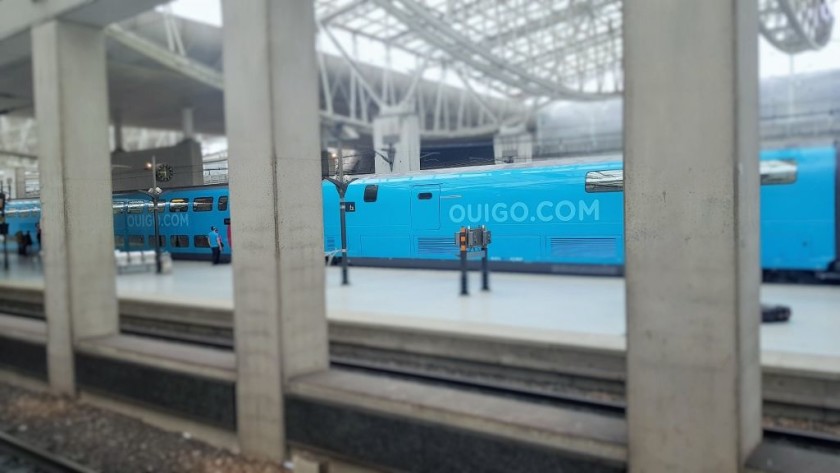
Ouigo services travel guide:
French rail operator SNCF has now divided its high speed TGV services into two categories.
(1) Standard TGV services = inOui
(2) These low cost TGV services = Ouigo
These Ouigo train are no-frills TGV services which use the same high speed lines as the standard (inOui) TGV services.
The difference to regular TGV services
Ouigo services...
(1) are 2nd class only,
(2) Some of the seating area on the lower deck is arranged 3 + 1 instead of 2+2
(3) have no catering facilities available*
(4) have no Wi-Fi etc,
(5) don't permit bikes on board,
(6) require pre-booking for pushchairs/strollers,
(7) have less generous luggage allowance - see below
(8) have more restrictive ticket booking options - see below
(9) have a different boarding procedure.
*=You can take cold food such as sandwiches on board with you on to Ouigo trains, but it seems as though hot food/'street food' is not permitted.
Routes:
A difference between standard inOui and low cost Ouigo services used to be that Ouigo trains didn't use stations in central Paris; though this is changing and an increasing number of Ouigo routes do serve central Paris stations.
The Ouigo routes are now:
(1) Paris Gare De Lyon - Lyon St Exupery (Lyon Airport) - Aix-en-Provence TGV - Toulon - St Raphael - Cannes - Antibes - Nice
(2) Paris Gare De Lyon - Lyon St Exupery (Lyon Airport) - Avignon TGV - Marseille
(3) Paris Gare De Lyon - Lyon Part-Dieu - Lyon Perrache (a recent addition meaning that Ouigo now serves Lyon city centre)
(4) Lille - Aepoort CDG - Marne la Vallée - Lyon St Exupery (Lyon Airport) - Avignon TGV - Aix-en-Provence TGV - Marseille
(4) Marne la Vallée - Lyon Part Dieu (central Lyon)
(5) Tourcoing* - Paris Aeroport CDG - Marne la Vallée - Lyon St Exupery (Lyon Airport) - Valence TGV - Nimes - Montpellier
(6) Tourcoing* - Paris Aeroport CDG - Marne la Vallée - Massy TGV - Angouleme - Bordeaux
*Tourcoing is connected to Lille by local trains (the Lille Metro and tram doesn't serve Tourcoing train station).
(7) Paris Est - Strasbourg - Colmar
(8) Paris Est - Metz
(9) Paris Est - Nancy
(10) Marne la Vallée - Paris Aeroport CDG - Champagne Ardennes TGV - Lorraine TGV - Strasbourg
(11) Paris Montparnasse - Poitiers - Bordeaux - Agen - Montauban - Toulouse
(12) Paris Montparnasse - Angers - Nantes
(13) Paris Montparnasse - Rennes
(14) Barcelona - Madrid
Connections from Central Paris:
- Marne la Vallée is a terminus of RER Line A - avoid the trains heading to Boissy-St-Legér
- Aeroport CDG is a terminus of RER Line B - avoid the trains heading to Mitry-Claye.
As Ouigo services share the high speed lines with other (more expensive) services, they're operated so that they won't cause delay to other trains, so they tend to be as punctual as the TGV InOui services; when departing on time.
Most of the delays to high speed trains in France are caused by very occasional issues with the tech equipment on the high speed line, and when that is occurring the other trains are delayed too, it won't just be the Ouigo services which are affected.
The tickets:
The major advantage of booking tickets for Ouigo trains is the price, as the prices for most journeys by Ouigo trains can cost as low as €10.
Though now that Ouigo trains depart from some stations in central Paris, the price policy of any Ouigo departure being available 'from €10' has evidently been discontinued.
Ticket prices can be more than 4 x cheaper than standard (inOui) services on comparable routes - though be aware of not making a like-for-like comparison.
A Marne La Vallé - Marseille journey is not the same as a Paris Gare De Lyon - Marseille journey etc.
The seven key things to be aware of are:
(1) It seems that only cards issued by European and U.S. banks can be used to book Ouigo tickets
(2) Tickets can now be booked on the E.U version of Oui.SNCF AND on Trainline.
So when looking up routes served by standard In-Oui trains AND Ouigo trains, the Ouigo departures can be compared with inOui departures, on the E.U version of SNCF's standard booking service, Oui.SNCF or on Trainline.
Use the generic from and to city names when searching such as 'Paris' and 'Marseille' and not the specific station names.
(3) Tickets can also be booked on the Ouigo website but it seems though you cannot book ahead for journeys unless you are accessing the site from within France.
(4) There are apparently differences between how tickets can be booked on the Ouigo website and the OuiSNCF website, the Ouigo site promotes the availability of a 'Ouigo Plus' offer, which includes additional benefits such as increased luggage allowance, seat selection and access to the equivalent of 'speedy boarding' at Paris terminals.
However, when booking on OuiSNCF you won't see the Ougio Plus option, but will be able to add seat selection and an additional luggage provision, as they are offered as 'extras' on its booking path.
(5) Tickets for Ouigo journeys cannot be booked at stations; and they also can't be be collected at stations - you either have to print them from the email you receive, or save them to your phone.
(6) The only type of ticket available for journeys by Ouigo are the 'Exchangeable Tickets' aka 'Leisure' tickets.
As pointed out on the Oui.SNCF website these tickets can't be refunded, if you subsequently cancel your travel plans compleletly, or miss your train due to a factor outside the control of SNCF; such as a broken down Metro train, or a taxi stuck in traffic.
However, they can be swapped to a different Ouigo departure on your travel date, up to an hour before the train you are booked on to is due to leave, but doing so will cost a €10 admin fee.
(7) Tickets are also only available for DIRECT longer end-2-end journeys by Ouigo trains and are not available for shorter journeys such as Marseille to Aix-en-Provence.
The booking window:
Tickets can be booked up to six months ahead of the travel date; usually.
In contrast tickets can typically only be booked only up to 4 months ahead for TGV inOui services - so when looking up the Ouigio routes on Oui.SNCF MORE than 4 months ahead on, you will typically only see Ouigo trains listed.
So don't assume in this scenario that only Ouigo trains will be an option for your journey, you will have to wait to see which alternative TGV inOui services will also be available, so that you can then compare departure times and prices with the Ouigo trains.
Child tickets:
Unlike on other train services in France, children aged 3 and under don't apparently travel for free on Ouigo trains.
A flat rate price is charged for children aged 11 and under of €5 per child, except for journeys to/from Paris Est, Paris Gare De Lyon and Paris Montparnasse when the flat rate price is €8.
Adding extras when booking:
Similarly to how budget airlines are operated Ouigo enables passengers to add benefits when booking for additional fees.
These are choosing your seats and options for taking additional luggage.
Choosing Seats:
All the seats on the Ouigo services have the same dimensions and offer similar levels of leg room, but there are major differences between the coaches on the train, as to how the seats are arranged; and this is why it can be a very good idea when booking on OuiSNCF, to at least look at the seat selection options.
The option to choose seats will be automatically offered when booking on OuiSNCF.

You won't be committed to paying the extra charge just by clicking on this button; and crucially you'll be able to see the seating plan.
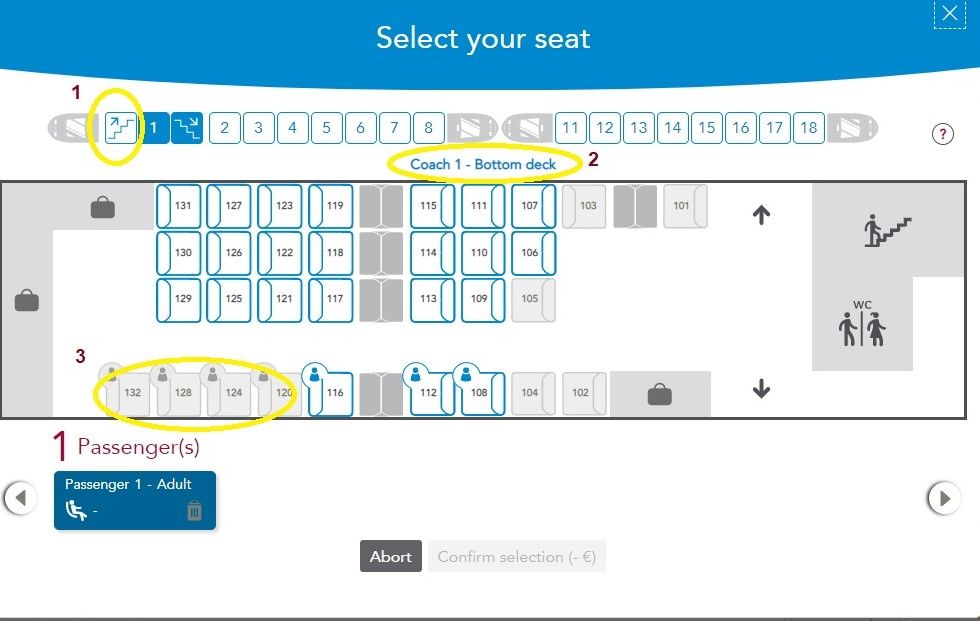
The key features of the seating plan to take note of are:
- All of the Ouigo trains are double-decked so when navigating through the plan, you can use the staircases to swap between the plans for the bottom (lower) and top (upper decks).
If you have a preference for travelling on the top deck, you will need to select a top deck seat on the seating plan, in order to ensure that you will be sat in this part of the train. - Keep an eye on whether you are looking at a plan for a bottom or top deck. It's a good idea to look through the train by using the row of coach numbers, but coach 4 has no bottom deck seating so it 'flips' the decks; start on the bottom deck 1; move along the train and click 5 and you'll be switched to seeing a top deck plan.
- The greyed out seats are those which have already been selected.
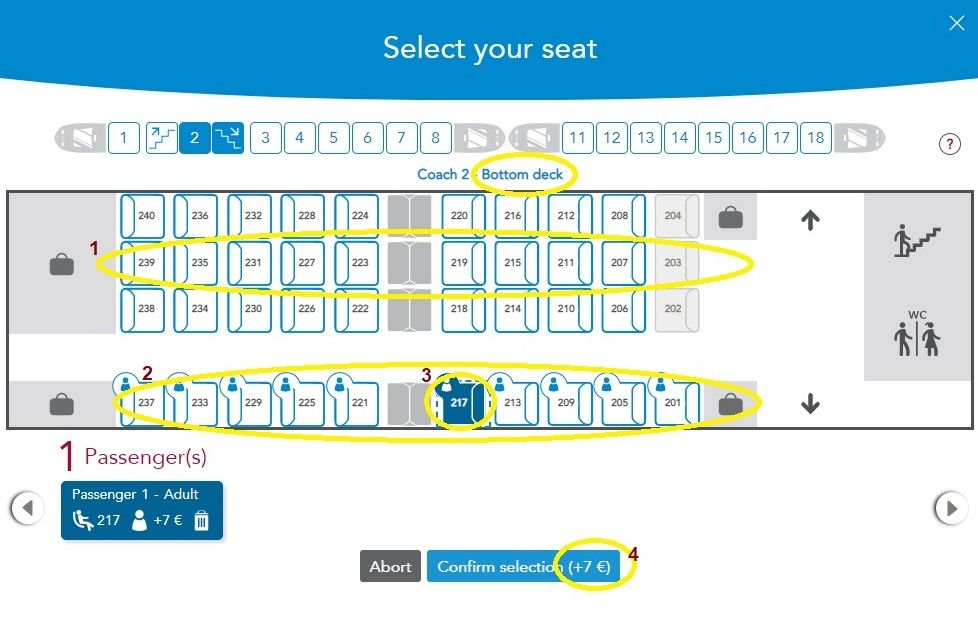
The arrangement of the seats is more varied in the bottom-deck, which is why it is worth looking through the train
What is being highlighted above is:
1: Some of the seats on the lower deck are in rows of three, and if you don't use the seat selection you could be assigned the middle-seat in this row, which isn't by the window and isn't on the aisle (though if you will be travelling in a party of three it could be worthwhile to target this row).
2: Some of the seats in this coach have no other seat beside them (and one of the key perks of travelling in 1st/Premiere Class on a standard TGV train is the access to this type of seat)
But because these 'solo' seats have obvious advantages, it's not likely that you will be automatically assigned one.
3: To ensure you will be sitting in such a seat, you have to select it on the plan.
4: And then having done so you'll see that these 'solo' seats have a €7 and not a €3 surcharge; so it can be worth factoring this in when comparing price of a Ouigo service to a 'Premiere Class' price on a standard TGV service.
Though these 'solo' seats are not available on the top decks in any of the coaches.

But not all bottom deck coaches on the Ouigo trains have the same seat arrangement, as can be seen above this coach has the 2+2 layout, which is also the norm in Standard Class on the TGV InOui trains; you will need to use the top row coach numbers to 'look' through the train, in order to find these different configurations.
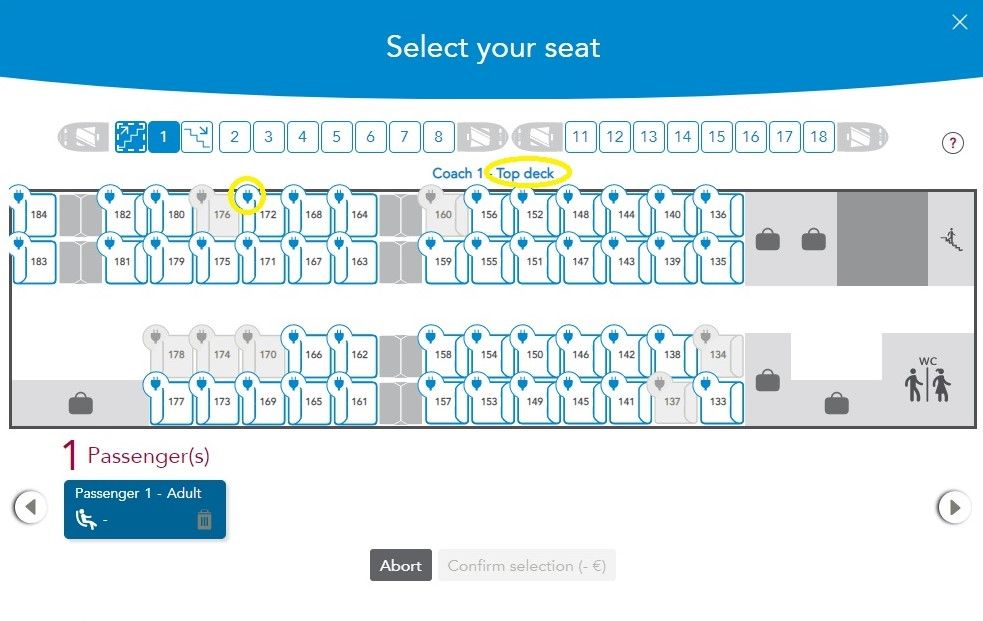
In certain coaches on a Ouigo train all of the top deck seats have access to power sockets; they're not available at all on the bottom deck.
If you want to be sure of having access to power during a long journey, you will need to be proactive and seek these seats out on the seating plan; they incur the same €3 charge as a standard seat without a socket
If you don't use the seating plan, it's unlikely that you will be automatically assigned a seat with a power socket.
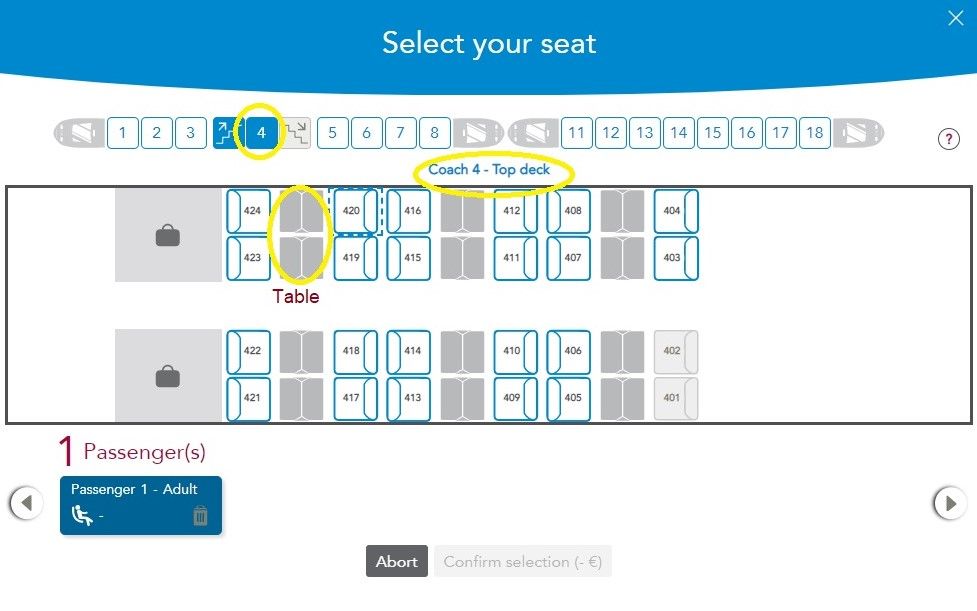
The seating arrangements across the top deck aren't universal, not only do some coaches not have power sockets, but the top deck in coach 4 has fewer seats and they all have access to a table; so it has an exceptional configuration.
Therefore if you don't want a 'solo' seat, but are happy to pay the €3 seat selection fee, and don't want a power socket, but would like a table, this is the coach to target.
Fewer seats lessen the possibility of being disturbed by fellow passengers, so this coach on a Ouigo compares particuarly favorably with the ambience of a typical Standard Class seating saloon on a TGV InOui train.
One other thing to keep in mind is that when selecting seats, there is now way of knowing whether you will be facing forwards or backwards during a journey.
Boarding:
If you will be travelling by Ouigo train you are requested to be at the station 30 mins before departure as all travellers need to pass through Ouigo reception.
According to the Ouigo website accessing the train isn't permitted less than 5 minutes before departure
The primary reason for the 30mins 'rule' is that you can't just walk on to a Ouigo trains, because in echoes of how budget airlines operate their boarding procedures, passengers in effect check-in.
Tickets are inspected along with what each passenger is bringing on board; primarily does the luggage they have with them exceed the limit, so the staff are checking whether an additional last minute luggage excess charges have to be applied etc.
Though on less busy departures and station calling points, the queue for boarding will typically have cleared more than 10 mins before departure, hence the reports we have seen from travellers on social media who have turned up a station only 10 mins before departure knowing that they don't have excess luggage etc, and have successfully boarded.
But take care, there will be big differences in volumes between the numbers of passengers boarding a Ouigo service in Marseille on a summer Saturday afternoon and those boarding in Agen on a winter Wednesday.
Therefore SMTJ's recommendation is to obey the 30 minute rule, those people 'getting away' with turning up a station with only 10 mins to spare, tend to be regular Ouigo travellers.
Though exclusive to bookings on the Ouigo website (which in effects means booking while in France) for journeys from the main terminals in Paris, an additional payment of €7 gives access to a 'Coupe-File' service; the English translation of which is 'skip the line', so this is in effect the equivalent of a 'speedy boarding' procedure.
If 'Coupe-File' is included within a booking, it is when adding the Ouigo Plus Offer to a booking on the Ouigo website, the requirement is to be a station only 10 mins before departure.
This does seems to imply that Ouigo will be somewhat less likely to wave last-minute arrivals through at Paris terminals, if the option hasn't been taken up to apply the 'Ouigo Plus Offer' to a booking.
The Quiet Areas/Zones:
Ouigo trains used to have designated 'Quiet Zones' in which mobile phone calls were not permitted etc, but it seems there are no longer available, as they are not offered when booking tikcets.
The luggage terms:
Each ticket holder can either board with two pieces of hand luggage not exceeding 36 x 27 x 15 cm (height x width x depth) OR 1 piece hand luggage 36 x 27 x 15 cm (height x width x depth) + 1 piece of cabin luggage not exceeding 55 x 35 x 25 cm (height x width x depth).
So in essence this means 2 pieces of hand luggage per passenger OR 1 larger bag + 1 piece of hand luggage.
This is in contrast to TGV (InOui) services, on which passengers can travel with two larger suitcases + one piece of hand luggage.
A €5 surcharge is available when booking, which purchases the ability to bring items within an increased limit
Three things in particular are worth keeping in mind.
- If you present yourself for boarding with luggage within the increased allowance, but haven't purchased the allowance for €5 in advance, you will be charged €20.
- You can add the €5 charge to a booking after you have purchased a ticket, if you subsequently realise you will need the increased allowance after all.
- Present yourself for boarding with luggage which exceeds the enhanced limit and you won't be taking the train, regardless of whether you have paid the €5 fee.
Also note that pushchairs/strollers etc are in addition to these luggage limits, so will need to be added to a booking.
Using rail passes:
Rail passes are not valid on Ouigo trains.

This is one of more than 150 train guides available on ShowMeTheJourney, which will make it easier to take the train journeys you want or need to make. As always, all images were captured on trips taken by ShowMeTheJourney.


